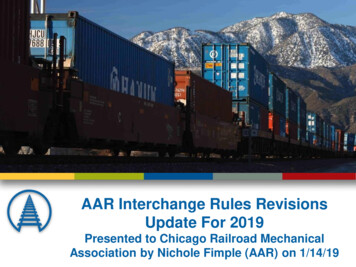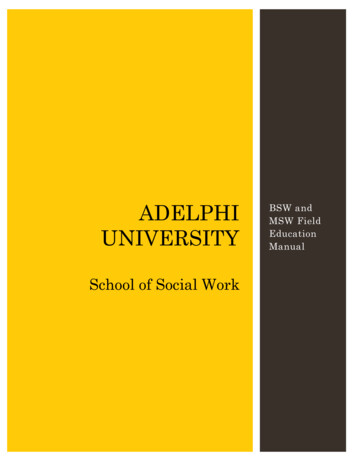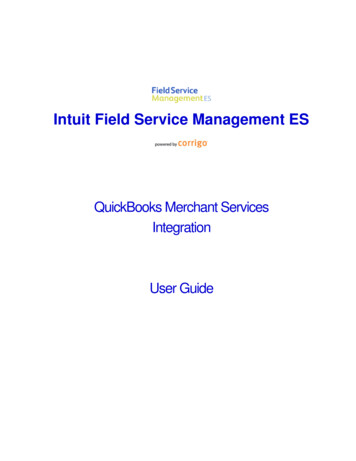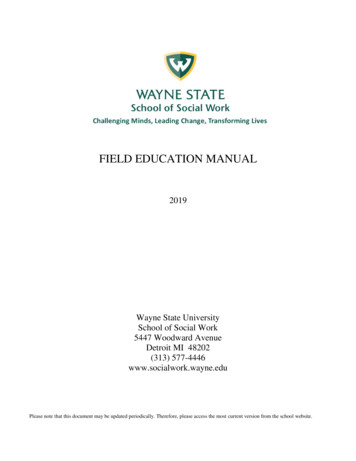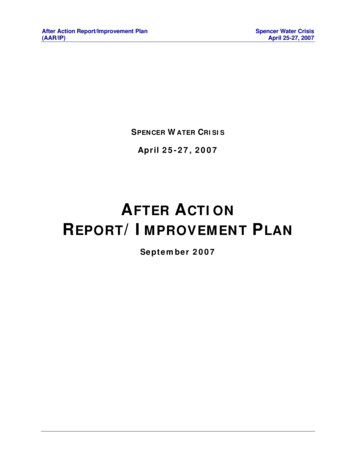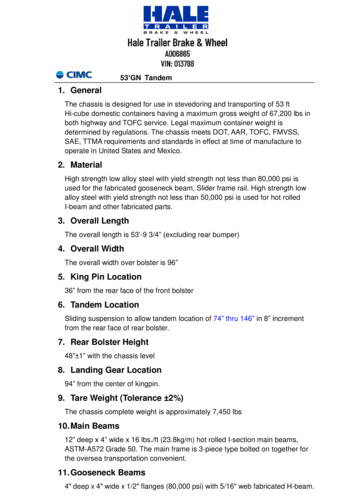
Transcription
2020FIELD MANUALOF THEAARINTERCHANGE RULES
AAR Full and Special Members
FIELD MANUALOF THEINTERCHANGE RULESADOPTED BY THEAssociation of American RailroadsSafety and OperationsRules and StandardsEffective January 1, 2020Published by theASSOCIATION OF AMERICAN RAILROADS425 3rd Street SWWashington, D.C., 20024 Association of American RailroadsPrinted in U. S. A.
Copyright 2020 by the Association of American Railroads (AAR)Safety and Operations425 3rd Street SWWashington, D.C. 20024All rights reserved, including the right to reproduce this book in any form. It is the AAR's intention that this publication be used to promote the objectives of the AAR and its members for thesafe, efficient, and uniform interchange of rail equipment in North America. To this end, onlyexcerpts of a rule or specification may be reproduced by the purchaser for their own use in promoting this objective. No portion of this publication may be displayed or otherwise made available to multiple users through any electronic distribution media including but not limited to alocal area network or the Internet. No portion may be sold or used for advertisement or gain byany entity other than the AAR and its authorized distributor(s) without written permission fromthe AAR.
Table of Contents(Job Code ranges follow the title of each Rule)Page #Rule ARule BRule 1567— Care of Freight CarsAIR BRAKE EQUIPMENT— Vacant— Testing of Air Brakes—(1128–1159)— Air Brake Valves and Parts—(1116–1612)— Air Brake Hoses, Hose Supports, and Trainlines—(1160–1630)— End Hose Arrangement Performance and Angle Cock Placement—(1210–1632)Rule 7 — Brake Beams, Hangers, Brackets, Wear Plates and BrakeConnection Pins, Hanger Pins, or Bolts—(1650–1742)Rule 8 — Automatic Slack Adjuster—(1574–4469)Rule 9 — Air Brake Cylinders and Parts—(1116–1506)Rule 10 — Brake Beam and Bottom Rod Supports—(1768–1770)Rule 11 — Brake Levers, Guides and Brake Connection Rods—(1153–1816)Rule 12 — Brake Shoes and Shoe Keys—(1830–1852)Rule 13 — Hand Brakes – Geared and Non-Geared—(1856–4482)Rules 14 and 15—Vacant104114126135139147154173COUPLERS, YOKES, DRAFT GEARS,UNCOUPLING LEVERS AND SUPPORT BRACKETSRule 16 — Couplers, Type E and Parts—(2004–4474)Rule 17 — Couplers, Type E/F and Parts—(2051–4478)Rule 18 — Couplers, Type F and Parts—(2075–4478)Rule 19 — Yokes, Type E—(2312–4470)Rule 20 — Yokes, Type E/F and F—(2354–4470)Rule 21 — Draft Gears, Carriers and Followers—(2400–4470)Rule 22 — Uncoupling Levers and Support Brackets—(2480–2486)Rule 23 — Articulated Connectors—(2600–2652)Rules 24 to 35—Vacant174205226251256261278290303ROLLER BEARINGS AND ADAPTERSRule 36 — Roller Bearings—(2814–2867)Rule 37 — Roller Bearing Adapters—(2870–2895)Rules 38 to 40—Vacant304319331WHEELS AND AXLES— Wheels—(3001–3151)— Vacant— Axles—(3250–3280)— Wheel Sets—(3328–3399)— Vacant332393394398408Rule 2Rule 3Rule 4Rule 5Rule 6Rule 41Rule 42Rule 43Rule 44Rule 45—1—1213356481
Table of Contents — ContinuedPage #TRUCKS, COMPONENTS OFRule 46 — Truck System Performance (3582–4467)Rule 47 — Truck Bolsters—(3520–4467)Rule 48 — Truck Side Frames, Transoms and Spring Planks—(3720–4467)Rule 49 — VacantRule 50 — Truck Springs and Snubbers—(3904–3954)Rules 51 and 52—VacantRule 53 — Running Boards—Dome Platforms—Brake Steps—Cross Platforms—(4001–4482)Rules 54 to 56—Vacant409434445454455459460467SILLS, REPAIRS TORule 57 — Center Sills, Draft Sills, and Coupler Carriers (2162–2168)Rule 58 — Side SillsRule 59 — Cushioned Underframe Devices—(3470–5884)468477480CENTER PLATES AND SIDE BEARINGSRule 60 — Body Center Plates—(4080–4082)Rule 61 — Body Side Bearings—(4090–4094)Rule 62 — Truck Side Bearings—(3572–4452)553556559Rule 63Rule 64Rule 65Rule 66Rule 67Rule 68Rule 69Rule 70Rule 71Rule 72Rule 73Rule 74Rule 75Rule 76Rule 77Rule 78Rule 79Rule 80Rule 81Rule 82Rule 83Rule 84GENERAL REPAIRS AND INSTRUCTIONS— Automatic Equipment Identification (AEI)—(4340–4358)— Tie Down and Load Restraining Devices—(4900–4930)— Trailer Hitches and Parts—(2574–5456)— Reflective Sheeting—(5500–5502)— Miscellaneous Instructions— Refrigeration Equipment—(4102–4180)— Miscellaneous Material—(4200–4246)— Lightweights, Weight Limits and Overloading— Card Boards and Receptacles—(4320–4330)— Manufactured Material—(1999–6999)— Trough Hatch Covers—(4360–4482)— Securement—(4400–4482)— Miscellaneous Labor—(2600–4489)— Straightening Parts Off Car—(4490)— Door and Door Parts—(4500–4540)— Lumber—(4550–4558)— Ladders, Ladder Treads, Handholds and Sill Steps—(4482–4595)— Markings—(4482–4628)— Tank and Tank Car Repairs—(4712–4764)— Welding and Allied Processes—(4482–4812)— Preparation of Original Record of Repair and Billing Repair Data— Use of Advertisements, Routing and Other 643647650654660669689MATERIALRule 85 — Furnishing MaterialRules 86 and 87—Vacant693694—2—
Table of Contents — ContinuedPage #Rule 88Rule 89Rule 90Rule 91Rule 92Rule 93Rule 94INTERCHANGE OF FREIGHT CARS— Mechanical Requirements for Acceptance— Conditions Governing Delivery and Acceptance— Cars and/or Car Parts Prohibited in Interchange— Service Interruption— Transfer or Adjustment of Lading Between Carriers— TRAIN II & Umler Reporting Procedures (See Office Manual)— Equipment Health Management Systems (EHMS)695706710714715719720RESPONSIBILITYRule 95 — Handling and/or Delivering Line ResponsibilityRule 96 — Owners ResponsibilityRule 97 — Contamination DamageRule 98 — VacantRule 99 — Cars on Private and/or Non-Subscriber TrackRules 100 and 101 – VacantRule 102 — Defect CardsRule 103 — Joint Inspection Certificate (See Office Manual)Rule 104 — Information CardsRules 105 and 106 – e 107 — Handling of Damaged or Destroyed Equipment (See Office Manual)Rule 108 — Cars Requiring Extensive Repairs—Owner’s ResponsibilityRules 109 and 110 – Vacant734736739GENERAL REGULATIONS FOR BILLINGRule 111 — Car Repair Pricing (See Office Manual)Rule 112 — Car Repair Billing (See Office Manual)Rule 113 — Car Repair Billing Data Exchange Procedures (See Office Manual)Rule 114 — Mandatory Contact List RequirementsRule 115 — Damaged and Defective Car Tracking (DDCT)Rules 116 to 119—VacantNote: Job Code ranges listed above are not necessarily inclusive.—3—740740740740741742
Table of Contents — ConcludedPage #GENERAL RULESRule 120 — AAR Rule Compliance and EnforcementRule 121 — Arbitration and Rules Committee (See Office Manual)Rule 122 — Interpretation of the Rules and Settlement of Disputes (See OfficeManual)Rule 123 — Revision of Rules (See Office Manual)Rule 124 — Participation in This Code of Rules (See Office Manual)Rule 125 — Early Warning/Maintenance Advisory (EW/MA) SystemRule 126 — Operational PracticesRules 127 to 130—VacantAppendix A —Appendix B —Appendix C —Appendix D —Appendix E —Appendix F —Appendix G —Appendix H —Appendix I —DefinitionsMulti-Level Maintenance PoolsCode of Rules for End-of-Train (EOT) Telemetry DevicesBilling Instructions Excerpted From: The National IndustrialTransportation League 1993 Rail Users’ Manual Private RailCar Standard Job CodesService Fees (See Office Manual)VACANTVACANTRunning Repair Agents (See Office 815818839840841842843
RULE 3 – TESTING OF AIR BRAKESA.Cause for Attention1. At Any Timea.Air brakes inoperative or cut out when car is set out of a trainb.Cars with an open MA-0063 or EW-5171c.Air brake test date information missing in Umlerd.Piston travel outside of nominal range as shown on Figures 3.1through 3.12 for the following:(1) Nominal piston travel FRA Class 1 initial terminal inspection(2) Piston travel ineffectivee.Car with open Line of Road Failure—No Cause Found (LORF-NCF)or Line of Road Failure—Air Hose Separation (LORF-AHS) EHMSalert.2.B.When on Shop or Repair Track for Any Reasona.Car is past due for a single car air brake test per the ABT due date inUmlerb.Piston travel outside of nominal range as shown on Figure 3.1 forMSRP S-486 travel limitsCorrect Repairs1. All freight cars must be tested and receive attention as required inCHART A of this Rule.2. Cars with air brake items listed in CHART A of Rule 3 and cars set out oftrains with air brake valves cut out en route must not be directed to anexpedite track unless such track is capable of performing the required AARSingle Car Air Brake Test (excluding those conditions requiring testing onshop or repair track).3. Before performing a Single Car Air Brake Test—account of overdate, referto the Umler file and to the Early Warning/Maintenance Advisory System todetermine test date requirements.— 13 —
CHART ATESTS AND ATTENTION REQUIRED PER MSRP S-486, LATEST REVISIONAll cars set out of trains requiring tests foritems listed below in Chart A, must receiveattention per Chart A while on the handlingline railroad.Brake PipeSingle Car LeakageAir BrakeTestTest(Sect. 3.3)X2) Air brakes inoperative or cut out when car isset out or on shop or repair trackX3) Attention per Rule 3.A.1.b. or Rule 3.A.1.c.X4) Car with wheel thermal cracks or condemnable built up tread or slid flat.X5) When car is on shop or repair track, wheelswith noncondemnable built-up tread or slidflat.XEmptyLoad Test(empty caronly)(Sect. 4.6)RetainerValveTest(Sect. 4.2)BrakeCylinderLeakageTest(Sect. 4.5)CleanDirtCollectorRenewPipeBracketFilter WhenUncoveredXXX6) Slack adjuster repaired or renewedX7) Empty/Load valve renewed8) Service portion, emergency portion or ABpipe bracket renewedX9) Control valve mounting gasket, reservoir, orpipe bracket stud renewedXSystemLeakageTest(Sect. 3.5)RULE 3— 14 —1) Car is past due for a single car air brake testper the ABT due date in Umler when car ison shop or repair track. If BC tap is notinstalled, apply approved brake cylinderpressure tap.SlackAdjusterTest(Sect. 4.1)
CHART ATESTS AND ATTENTION REQUIRED PER MSRP S-486, LATEST REVISIONAll cars set out of trains requiring tests foritems listed below in Chart A, must receiveattention per Chart A while on the handlingline railroad.Brake PipeSingle Car LeakageAir BrakeTestTest(Sect. 3.3)SlackAdjusterTest(Sect. 4.1)EmptyLoad Test(empty caronly)(Sect. 4.6)RetainerValveTest(Sect. 4.2)SystemLeakageTest(Sect. 3.5)X11)Brake pipe or branch pipe repaired orrenewed, dirt collector/cut out cock, emergency vent valve, Quick Service valve orblanking plate, angle cock, end hose orintermediate hose renewed (test only ifrepaired on repair track)X12)Retaining valve replaced or retaining valvepipe repaired or replaced (test only ifrepaired on repair track)X13)Reservoir piping repaired or renewed (testonly if repaired on repair track)14)Car with open Line of Road Failure—No Cause Found (LORF-NCF) EHMSAlertCleanDirtCollectorRenewPipeBracketFilter WhenUncoveredRULE 3— 15 —10)Brake cylinder cleaned or renewed, brakecylinder pipe repaired or renewed, brakecylinder hose renewed, brake cylinder relayvalve or Modulating valve renewed. If BCtap is installed, use Brake Cylinder LeakageTest. If BC tap is not installed, applyapproved brake cylinder pressure tap. (testonly if repaired on repair track)BrakeCylinderLeakageTest(Sect. 4.5)XX
RULE 34. Air brake test information must be reported to the Umler file within 24 hoursof repair date by the repairing company when Single Car Air Brake Test hasbeen performed. Refer to AAR Office Manual Rule 93.5. Single Car Air Brake Testing must be performed at 90 psi.6. Any car requiring a Single Car Air Brake Test must be equipped with anapproved pressure measurement tap and use the Brake Cylinder LeakageTest Gauge Method. If a car is not equipped, install required tap(s) asfollows. Refer to AAR standard S-4020 for detailed information. The newlyapplied tap shall be mounted such that it is always pointed at or above thehorizontal position to prevent trapping moisture. This does not apply to tapsmounted on empty/load devices.a.For cars (or articulated units) with single capacity brake systems anda single reservoir (per unit), the preferred location of the brakecylinder pressure tap is within a two-foot radius around the exteriorsurfaces of the pipe bracket where possible. The tap must be locatedin the piping to the brake cylinder(s), in a blanking plate mounted onthe brake cylinder (on cars with single brake cylinders) or in a coverplate applied to an automatic test device access port. If there is a pipeplug already in place, remove the plug and apply the pressure tap.b.For cars with empty/load valves, the preferred location is within a twofoot radius around the exterior surfaces of the empty/load valve wherepossible. There must be one pressure tap applied for each empty/load device on the car. The tap must be located in the piping from theempty/load device to the brake cylinder(s), on a blanking platemounted on the brake cylinder (on cars with single brake cylinders) oron the empty/load device. If there is a pipe plug already in place, inthe proper location, remove the plug and apply the pressure tap.c.For cars with relay valves and multiple reservoirs, one brake cylinderpressure tap shall be applied in accordance with 3.B.6.a. or 3.B.6.b.and additional tap(s) shall be located between the relay valve(s) andthe brake cylinder(s) being controlled by the relay valve. If the relayvalve controls only one cylinder, a tap mounted in a blanking plate onthe cylinder may be used.7. When performing a Single Car Air Brake Test, reflective sheeting must beinspected and cleaned per Rule 66—Reflective Sheeting.8. When performing a Single Car Air Brake Test in shop or on repair track, carsequipped with F-Type trainline brackets (see Rule 17, Figure 17.2) using a7/8 inch pin retainer bolt shall have the bolt replaced with a pin assemblyaccording to Rule 17.B.12.— 16 —
RULE 39. A car on a shop or repair track shall be tested to determine that the airbrakes apply and remain applied until a release is initiated, and the pistontravel shall be inspected.a.The following steps are required:(1) Charge the car to 90 psi(2) Make a 30 psi brake pipe reduction(3) Reduction must not produce an emergency application(4) Confirm brake shoes are against all wheels(5) Inspect for nominal piston travel(6) Recharge brake pipe to 90 psi(7) Brakes must release10. For piston travel requiring adjustment, refer to the initial setup column inFigures 3.1 through 3.12 and to the appropriate standard, S-4009,“Compression Slack Adjusters—Inspection, Testing, Removal, andApplication,” or S-4010, “Tension Slack Adjusters—Inspection, Testing,Removal, and Application.” Adjustment of piston travel is a non-billableitem, except for Job Codes 1150 through 1152.11. When setting piston travel on cars equipped with empty/load devices,condition the empty/load equipment for a loaded brake setting. For detailedinstructions for setting equipment to loaded position, refer to MSRP S-486.12. During accelerated application, valve operation of the NYAB DB-20emergency portion, air may be observed escaping from the interface of theside cover and body. This is air which is being released to exhaust by theoperation of the accelerated application valve and does not constitute acondemnable leak (see Rule 4, Figures 4.12 and 4.13).13. During release valve operation, an intermittent escape of air may be notedaround the bottom cover of the release valve. During the initial stages of abrake application, an intermittent escape of air may be noted around thebottom cover of the service portion. This is air that is being released toexhaust by operation of the valve portion and does not constitute acondemnable leak (see Rule 4, Figures 4.12 and 4.13).14. New gaskets must be applied to both end air hoses whenever a car is on ashop or repair track for any reason.15. Operating components of movable end-of-car hose assemblies must beinspected for proper travel and restrictions per Rule 6. Any binding shouldbe corrected and repairs must conform to the original or approved modifiedconstruction of the car. Contact car owner with questions.16. When on shop or repair track, inspect and test hand brakes in accordancewith AAR Standard S-486 Hand Brake Inspection Requirements. Paint tohand brake chain as shown in Rule 13 is to be applied and maintained attime of single car air brake test. Hand brake chain must be painted andmaintained per Rule 13.17. When on a shop or repair track; beams, brake hangers, hanger pins andbrackets, bottom rod and brake beam safety supports should be inspectedand renewed or repaired per Rule 7.— 17 —
RULE 318. Slack adjusters repaired or renewed on other than repair track may betested without the use of a single car test device. 20 psi reductions must bemade from a brake pipe pressure of at least 80 psi. All other steps in MSRPS-486 paragraph 4.1 must be followed.19. Except for cars equipped with either a 10 inch or an 81/2 inch diameterbody-mounted brake cylinder, all cars must have legible decals, or stickersaffixed to the car or must be equipped with a badge plate displaying Initial setup information The permissible brake cylinder piston travel range for the car when performing the initial terminal (Class I) brake test and inspection The length at which the piston travel renders the brake ineffective, if different from the initial terminal brake test and inspection limits.a.Decals must meet the requirements of AAR Specification M-947 andmust be a minimum size of 7 inch by 8 inch. See Rule 80 forapplication and billing.20. When a car is inspected and tested per Chart A line 14 or a car is inspectedfor a LORF-AHS EHMS alert, considerable special attention must be givento the following items during car inspection, since they are known to be keycontributors to Undesired Emergency (UDE) events: Excessive wear, slack, or bending on A or B end uncoupling levers. Alsocheck toggle clearance where the cut levers and lock lift interact. Bent, broken, or defective end air hose arrangements. Reworked or fabricated arrangements may require additional focus. Pay special attentionto trolley arrangements for proper travel and binding or fouling, bent, orbroken conditions. A and B end hose support conditions and proper adjustment for height. A and B end angle cock conditions. Trainline conditions that may contribute to a stretch leak (broken bracketsand missing pipe clamps, for example) A and B end intermediate air hoses must be inspected thoroughly, especially for issues that would arise during transition of slack action, such asbinding through support mechanisms, pinching, and incorrect length.Inspect through range of travel.21. Per Chart A line 14, one additional Service Stability Test (S-486 3.8) andone additional Separate Vent Valve Test (S-486 3.4.3, if equipped) must beperformed if a car passes the SCABT without replacement of any of thefollowing: a service valve, emergency valve, A-1 reduction relay valve, ventvalve, B1 quick-service valve, or pipe bracket.— 18 —
RULE 3Body Mounted BrakesFIGURE 3.110" 12" Cylinder (Standard)TravelInitial set-upand/oradjustmentrequired. /- 1 4"NominalPistonTravelFRA Class IInitial TerminalinspectionS-486Travel LimitsPiston TravelIneffective inexcess of:Standard10" 12"71 2"6" to 9"7" to 9"101 2"81 2" 12"71 2"6" to 9"7" to 9"101 2"7" 12"71 2"7" to 9"7" to 9"101 2"71 2" 11"71 2"7" to 9"7" to 9"91 2"71 2"7" to 9"7" to 9"91 2"Cylinder71 2" 12"(Bushed10" 12"Cylinder)— 19 —
RULE 3FIGURE 3.212" 10" CylinderTravelTravelCylinderInitial set-up andor adjustmentrequired. /- 1 4"NominalPiston TravelFRA Class IInitial TerminalinspectionPiston TravelIneffective inexcess of:12" 10"51 2"5" to 7"81 2"FIGURE 3.375 8" 12" Cylinder (UC)TravelCylinder75 8" 12" 9"(UC)Initial set-up andor adjustmentrequired. /- 1 4"NominalPiston TravelFRA Class IInitial TerminalinspectionPiston TravelIneffective inexcess of:51 2"5" to 6"71 2"— 20 —
RULE 3Truck Mounted BrakesFIGURE 3.4Ellcon-NationalBrake cylinder mounted off the truck bolster on two anglesTravelCylinderInitial set-up andor adjustmentrequired. /- 1 4"NominalPiston TravelFRA Class IInitial TerminalinspectionPiston TravelIneffective inexcess of:Ellcon-National23 4"21 4" to 33 4"4"FIGURE 3.5Thrall/Davis/TriaxBrake cylinder mounts directly to the bolsterTravelCylinderInitial set-up andor adjustmentrequired. /- 1 4"NominalPiston TravelFRA Class IInitial TerminalinspectionPiston TravelIneffective inexcess of:Thrall/Davis/Triax31 4"23 4" to 41 4"41 2"— 21 —
RULE 3FIGURE 3.6Wabcopac/NycopacWabcopac II/Nycopac IIATriax-IIBrake cylinder is part of the brake beam assemblyBrake BeamTravelInitial set-up andor adjustmentrequired. /- 1 4"CylinderNominalPiston TravelFRA Class IInitial TerminalinspectionPiston TravelIneffective inexcess of:Wabco/Nycopac11 4"Triax-II13 4"11 2" to 3"31 4"Wabcopac II21 4"13 4" to 3"31 4"EXT21 4"13 4" to 3"31 4"Nycopac IIANANASee note3 4"to 3"4"NOTE: System has no measurable piston travel minimum or maximum. Excessive travelis indicated by an over-travel indicator located on brake cylinder housing. Indicatorextended indicates cylinder travel is more than 21 4" (Unacceptable) attention required.Over ENYCOPAC IIABrake SystemIndicatorsACCEPTABLE— 22 —
RULE 3FIGURE 3.7Wabco TMXBrake cylinder is part of the brake beam assembly1 ReleasedTravelCylinderInitial set-up andor adjustmentrequired. /- 1 4"NominalPiston TravelFRA Class IInitial TerminalinspectionPiston TravelIneffective inexcess of:Wabco TMX2"11 2" to 3"31 4"— 23 —
RULE 3FIGURE 3.8TTX (Misner)Rubber air actuator is mounted on the brake beamTravel withmeasurement platesTravel withoutmeasurement platesInitial set-up andor adjustmentrequired (on emptycar only). /- 1 8"Nominal TravelFRA Class I orInitial TerminalinspectionTravelIneffective inexcess of:TTX91 4" 1 8"(on empty car only)71 2" to 10"101 4"TTX-II8" 1 4"7" to 9"91 4"CylinderNOTE: The original TTX TMB has a mechanical empty/load system activated by aramped block. The TTX-II TMB is equipped with pneumatic empty/load valves whichdoes not require a ramped block.— 24 —
RULE 3FIGURE 3.9Wabtec UBXBrake cylinder or rubber actuator is mounted on the brake beamTravelCylinderInitial set-up andor adjustmentrequired 1 4"Nominal TravelFRA Class I orInitial TerminalinspectionTravelIneffective inexcess of:(SHORT TRAVEL)33 4"31 4" TO 51 4"51 2"(LONG TRAVEL)41 2"31 4" TO 51 4"51 2"— 25 —
RULE 3FIGURE 3.10NYAB TMB-60Travel AcceptableRed ColorTop of CylinderYellow ColorTravel UnacceptableRed ColorTop of CylinderCylinderInitial set-up andor adjustmentrequired. /- 1 4"NominalPiston TravelFRA Class IInitial TerminalinspectionPiston TravelIneffective inexcess of:NYABTMB-602" only redcolor showing2" only redcolor showing31 4" yellowcolor showing— 26 —
RULE 3FIGURE 3.11UNIFRATETRAVELCylinderInitial Set-up andOr adjustmentRequired /- 1 4"Unifrate3"NominalPiston TravelFRA Class IInitial Terminalinspection3" MIN4-1 2" MAX— 27 —Piston TravelIneffective inExcess of:5"
RULE 3FIGURE 3.12ABEX/ABSCOTRAVELCylinderInitial Set-up andOr adjustmentRequired /- 1 4"ABEX/ABSCO5-3 4"C.Recondition RequirementsD.Welding RequirementsNominalPiston TravelFRA Class IInitial Terminalinspection5" MIN6-3 4" MAX1. Not applicable.1. Not permitted unless otherwise specified.— 28 —Piston TravelIneffective inExcess of:7"
RULE 3E.General Information1. All job codes per Section F are owners responsibility, at all times.2. Charges for truck mounted piston travel adjustments are not permitted inconjunction with wheel, single car air brake test, brake beam, slack adjuster,slack adjuster actuator/control rod, or brake cylinder renewal and/or brakecylinder cleaning on same truck.3. a.b.c.Charges are permissible when truck mounted brakes with slackadjusters shown in Figures 3.4, 3.5, 3.6, 3.7, 3.8, 3.9, 3.11, and 3.12are adjusted.The following truck mounted piston assemblies do not requireadjustment: Nycopac IIA and TMB 60.UNIFRATE (Figure 3.11) and ABSCO (Figure 3.12) are no longer inproduction; use Job Code 4450, Rule 75, if adjustments are made.d.Truck Mounted Piston Assembly Qualifier acB01Ellcon NationalB02EXTB03Thrall DavisB04TTX-(Misner)B05TTX-IIB06TMXB07Triax IIB08UBXC01Wabcopac II4. Multi-unit cars have multiple brake sets—each set comprising a controlvalve and appurtenances. When one brake set is tested for cause (perChart A), each remaining brake set must receive a separate Single Car AirBrake Test. Report one test date to the Umler file. When a tap is added toone brake system, each remaining brake system must have tap applied andtested.5. All car owners must ensure that initial air brake testing information isreported to the Umler file in the form prescribed by the current AAR UmlerData Specification Manual.— 29 —
RULE 36. Problems reporting air brake test information to the Umler file should bedirected to: csc@railinc.com.7. Why Made Code 12 may not require a billable item.8. If evidence is available that a non-condemnable built up tread or slid flatwere caused by hand brakes having been left on, do not test the car.9. Report why made 24 when test described by Job Code 1144, 1145, or 1146is performed for noncondemnable built up tread or slid flat. Do not reportwhy mades 12, 20 or 21 for this cause for attention.10. If car is listed in Maintenance Advisory MA-63 or Early Warning EW-5171,“Cars Overdue for Periodic Air Brake Testing”, and Single Car Test isperformed, Job Code 1139, Job Code 1140, or Job Code 1142 should bereported and car must be removed from Maintenance Advisory MA-63 orEarly Warning EW-5171.11. If a car is tested for MA-63 or EW-5171 and has an open EHMS LORF-NCFalert, complete the LORF-NCF procedure per Rule 3.12. A LORF-NCF EHMS alert is activated when a car has a Unique CarGrouping Count (UCGC) of three or more. A UCGC is the number of uniquegroupings of cars surrounding and including the car in question when one ormore LORF-NCF events have occurred.13. When a car is inspected and tested per Chart A line 14,a.Report the SCABT associated with a LORF-NCF cause for attentionusing Why Made Code 1A when no other Why Made Code applies.b.The applicable LORF-NCF EHMS alert must be closed once theinspection and the SCABT are complete, within 24 hours.14. A LORF-AHS alert is activated when a car has experienced three unique airhose separations with any partnering car or two unique air hose separationswith different partnering cars.15. The applicable LORF-AHS EHMS alert must be closed using JobCode 1128 once the inspection is complete, within 24 hours.16. Defects related to piston travel that is outside of nominal range, asdescribed in A.1.d. and A.2.b., only require piston travel adjustment, not asingle car test, unless a single car test is otherwise required by CHART A.17. Additional charge per Rule 75 may be made if jacking of car is necessary tosafely accomplish repairs. The jacking procedure utilized to perform repairssafely will be determined by the repairing facility and/or repair force.Exception to choice of jacking procedure will not be allowed.18. Any additional labor required to effect repairs and/or necessary attention toarticulated equipment should be billed per Job Code 2600, 2605, or 2610,Rule 23.19. Any additional labor required to effect repairs and/or necessary attention tointerconnected tank equipment should be billed per Job Code 4760,Rule 81.20. Any additional labor required to effect repairs and/or necessary attention todraw bar connected equipment should be billed per Job Code 4462,Rule 75.— 30 —
RULE 321. Inspection and cleaning of reflective sheeting at time of single car air braketest is included in Single Car Air Brake Test Job Codes, no additional laborcharges allowed.F.Billing Repair Data Requirements1. Locationa.Show location for Job Codes 1150, 1151, 1152, and 1155 per truck.b.Show location on articulated cars and drawbar-connected cars asstenciled on reservoir for Job Codes 1139, 1140, 1142, 1144, 1145,1146, 1147, 1155, 1157 and 1159.2. Quantitya.Show quantity.3. Condition Code0 Labor Attention7 Service Attention4. Job Code Applieda.Show applicable codeb.Show qualifier per Section E. for job codes preceded by **5. Descriptiona.Show applicable description6. Why Made Code (use only Why Made Codes shown for specific job codes)1A Undesired Emergency, Line of Road Failure-No Cause Found(LORF-NCF) EHMS Alert09 Account Repairs12 Inoperative13 Attention Required as Directed by Maintenance Advisory or EarlyWarning Letter20 Air Brakes Cut Out21 Overdate/Overage24 Attention Required25 Owner’s Request28 Adjustment Required7. Job Code Removeda.Show applicable Codeb.Show qualifier per Section E. for job codes preceded by **8. Responsibility Code1 Owner— 31 —
RULE 39. Job Codes and Standard Reporting DescriptionsJobCodeDescription1128INSPECTION ASSOCIATED WITH EHMS LORF-AHS ALERTInspection per Rule 3.B.20.Report car associated with EHMS LORF-AHS alert.(Condition Code 0)(Why Made Code 24)1130ADDITIONAL SERVICE STABILITY TEST WHEN ASSOCIATED WITHEHMS LORF-NCF ALERTOne complete Service Stability test performed.Charge is permissible only for a car associated with EHMS LORF-NCF alert.(Condition Code 7)(Why Made Code 1A)1132ADDITIONAL SEPARATE VENT VALVE TEST WHEN ASSOCIATED WITHEHMS LORF-NCF ALERTOne complete Separate Vent Valve test performed.Charge is permissible only for a car associated with EHMS LORF-NCF alert.(Condition Code 7)(Why Made Code 1A)1139SINGLE CAR AIR BRAKE TEST USING A MANUAL SINGLE CAR TESTINGDEVICE, 1 SET PER MAINTENANCE ADVISORY MA-63 OR EARLY WARNING EW-5171One complete set freight brake equipment including brake cylinder pressuretesting. Use only when car is listed in Maintenance Advisory MA-63 or EarlyWarning EW-5171, “Cars Overdue for Periodic Air Brake Testing.” Charge notpermissible when Job Code 1145 is performed on the same brake set. Forcars with multiple brake sets, only one charge for Job Code 1139 is permissible per car. Bill the testing of remainin
FIELD MANUAL OF THE A A R INTERCHANGE RULES. AAR Full and Special Members. FIELD MANUAL INTERCHANGE RULES OF THE ADOPTED BY THE Published by the Association of American Railroads . Rule 37 — Roller Bearing Adapters—(2870–2895) 319 Rules 38 to 40—Vac
